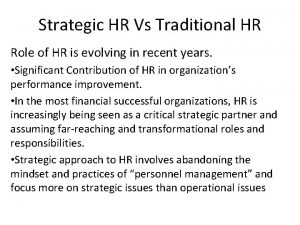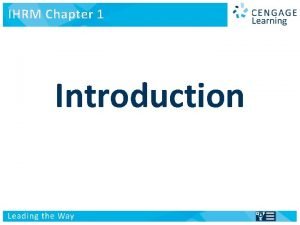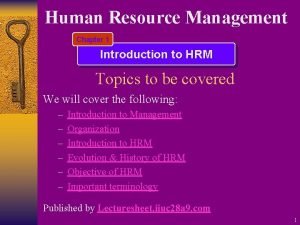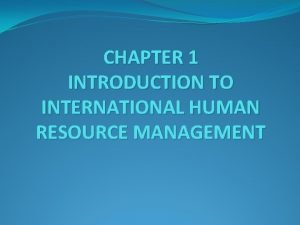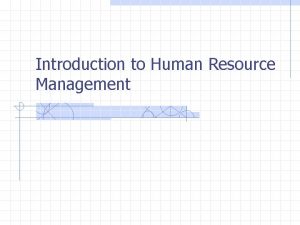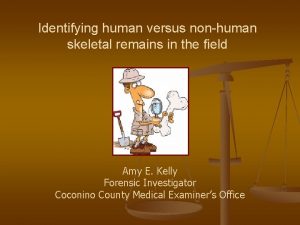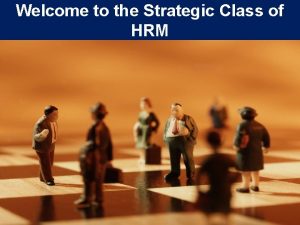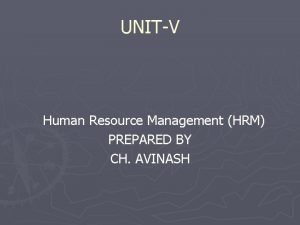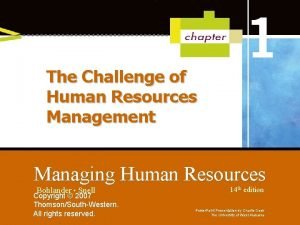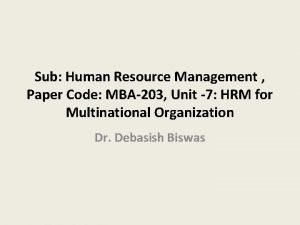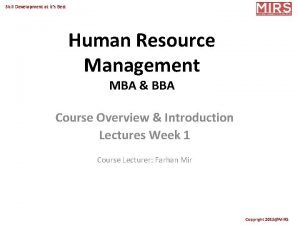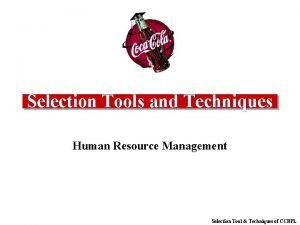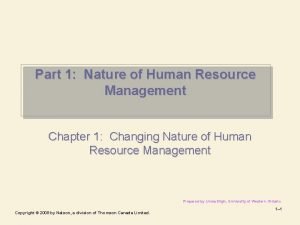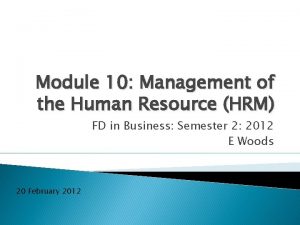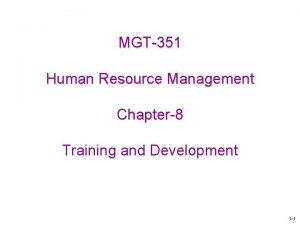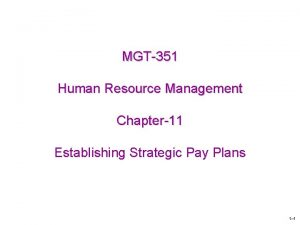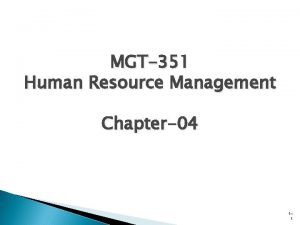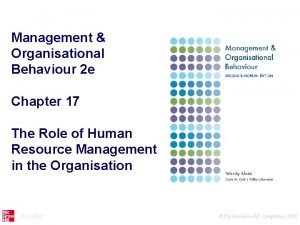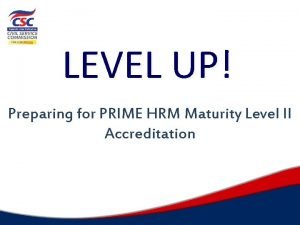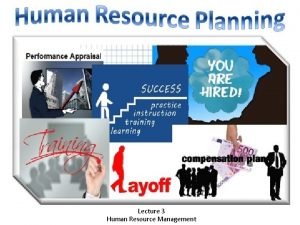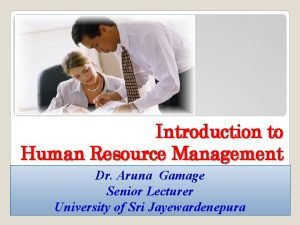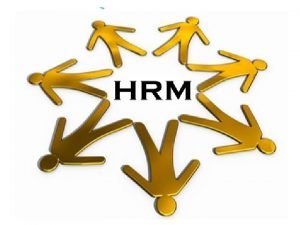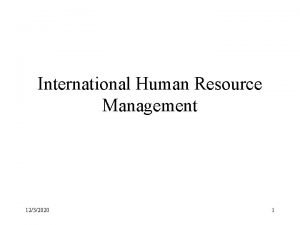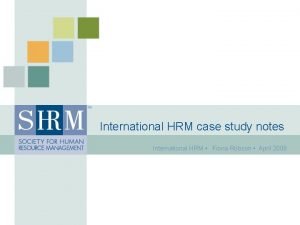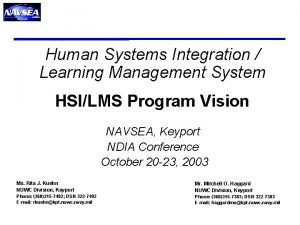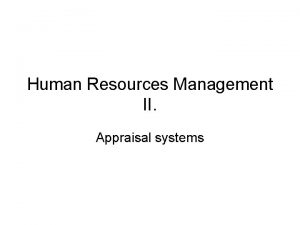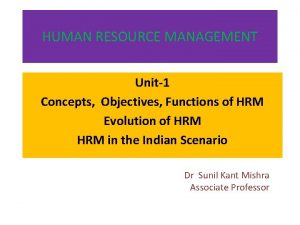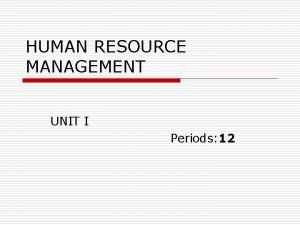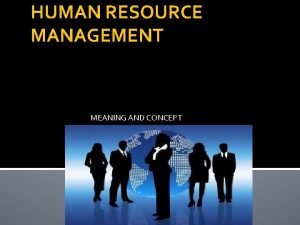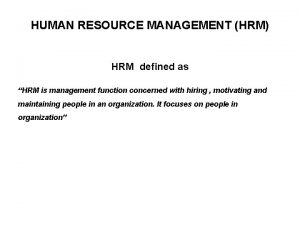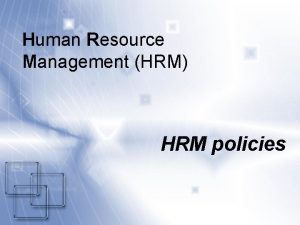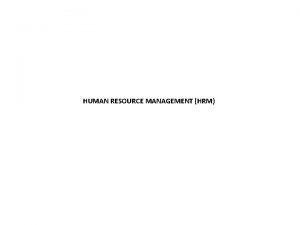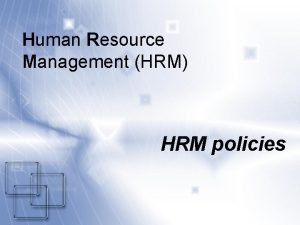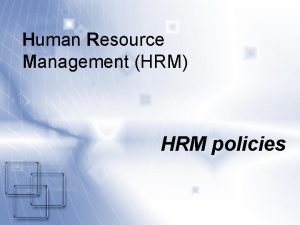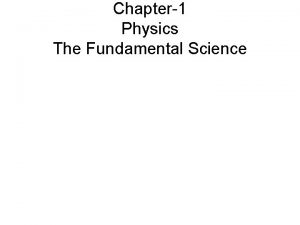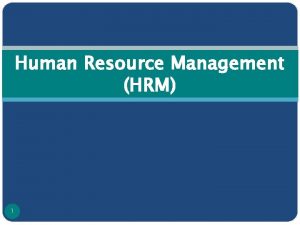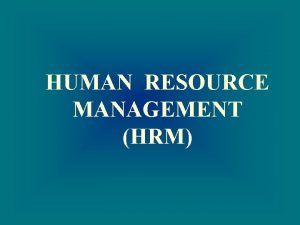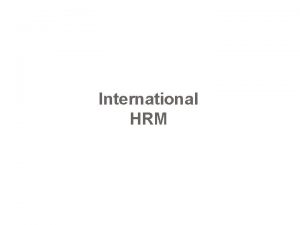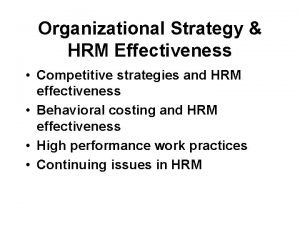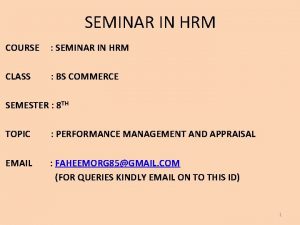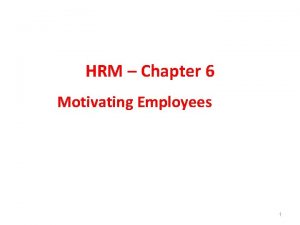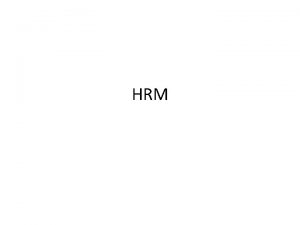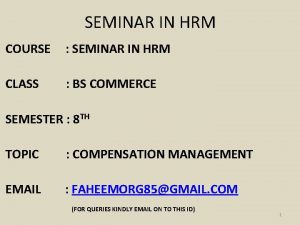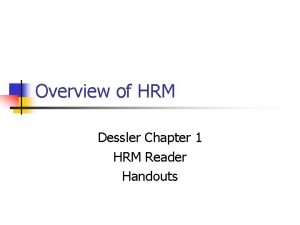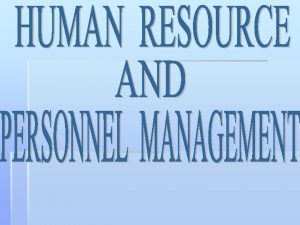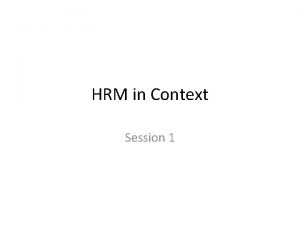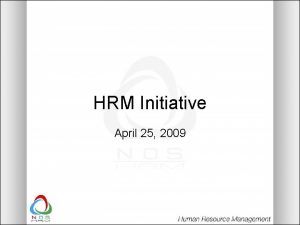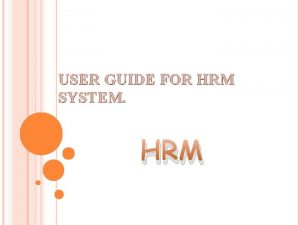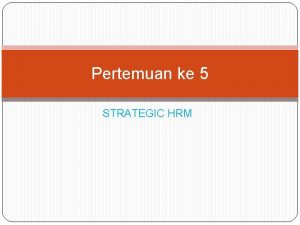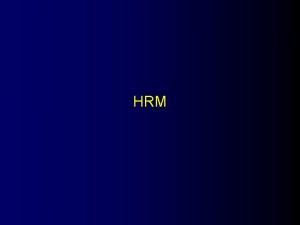Introduction to HRM 1 Chapter1 Introduction to Human












































- Slides: 44

Introduction to HRM 1

Chapter-1 Introduction to Human Resource Management Introduction to HRM 2

Human • • • Large brain size Expanded planning and problem solving abilities Complex cultural learning dependent on symbolic information Dependence on technology for survival Worldwide geographic distribution and adaptation to diverse climates and habitats Greater social complexity Resource Available source of wealth; a new or reserve supply that can be drawn upon when needed Management Manageme nt is the art of getting things done through the efforts of others. 3 Introduction to HRM

Definition of Human Resource Management Ricky W. Griffin: Human Resource Management is the set of organizational activities directed at attracting, developing and maintaining an effective work force. Gray Dessler: The policies and practices involved in carrying out the people or human resource aspects of a management position including recruiting, screening, training, rewarding and appraising. Introduction to HRM 4

Mathis and Jackson: Human Resource Management is the use of Human Resources in an organization through the management of people related activities. De. Cenzo and P. Robbins: Human Resource is comprised of the staffing, development, motivation and maintenance functions. Each of these functions however is affected by external influences. Introduction to HRM 5

Milkovich & Boudreau: Human Resource Management is a series of decisions that affect the relationship between employees and employers; it affects many constituencies and is intended to influence the effectiveness of employees and employers. Dale Yoder: Human Resource Management is the provision of leadership and direction of people in their working or employment relationship. Introduction to HRM 6

Dr. M. Ataur Rahman: Human Resource Management may be defined as a set of activities which include acquisition, development, motivation, maintenance and utilization of manpower for the purpose of effective and timely achievement of organizational goal/s. Introduction to HRM 7

Characteristics of Human Resource Management 1. 2. 3. 4. 5. Development of well HR policy: Development of harmonious relations: Establishing a chain of command: Awareness of own nature of services: Acquire full professional and operational knowledge: 6. Must be good communicative and effective leader: Introduction to HRM 8

Principles of Human Resource Management 1. Principle of scientific selection: 2. Principle of employee development: 3. Principle of labor management cooperation: 4. Principle of free flow of commutation: 5. Principles of fair remuneration: 6. Principles of incentive: Introduction to HRM 9

Principles of Human Resource Management 7. Principles of dignity of labor: 8. Principle of participation: 9. Principle of team spirit: 10. Principle of contribution: Introduction to HRM 10

Basic Functions of Human Resource Management 1. Acquisition: 2. Development: 3. Motivation: 4. Maintenance: Introduction to HRM 11

Basic Functions of HRM 1. Recruitment: Identifying and attracting qualified people to apply for vacant positions in an organization. 2. Selection: The process by which companies choose people to fill vacant position in the organization. 3. Training and development: The processes by which employees acquire the knowledge, skills, and abilities to perform successfully both in current jobs and in the future jobs they will have in their organizational careers. Introduction to HRM 12

4. Performance appraisal: The system used by an organization to measure and assess employees work performances. 5. Compensation: The organization’s entire reward package, including not only financial rewards and benefits, but also no tangible rewards such as job security. 6. Labor management relation: The continuing relationship between an employer and employers who are represented by labor organization. Introduction to HRM 13

General Functions of Human Resource Management 1. Formulation of Human Resources Policies 2. Procurement and selection of efficient employees 3. Guidance and placement: 4. Training and development 5. Promotion and transfer Introduction to HRM 14

General Functions of Human Resource Management (Cont. -------) 6. Job analysis 7. Maintenance of working environment 8. Protection of employees 9. Employee Services 10. Remuneration: Introduction to HRM 15

General Functions of Human Resource Management (Cont. -------) 11. Job and Merit Evaluation: 12. Labor Management Relations: 13. Workers’ Participation 14. Agreements with Trade Unions 15. Leadership and Co-operation: Introduction to HRM 16

General Functions of Human Resource Management (Cont. -------) 16. Providing benefits and rewards: 17. Maintaining discipline: 18. Career planning and development: 19. Handling grievances: 20. Reviewing employee needs: Introduction to HRM 17

Importance of Human Resource Management 1. Policy Formulation 2. Policy execution 3. Review of employee needs 4. Utilization of human resources 5. Social welfare development 6. Overall development of organization 7. Effective trade unionism Introduction to HRM 18

Phases of Human Resource Management 1. Pre-hire phase: 2. Hiring Phase: 3. Post-hiring phase: Introduction to HRM 19

Difference between Personnel and Human Resource Management Dimensions Personnel Management Human Resource Mgt 1. Definition Personnel management is the process of hiring and developing employees so that they become more valuable to the organization. Human resource management is the process of hiring, developing and maintaining of effective workforces in an organization. 2. Key Concern Labors All employees Introduction to HRM 20

3 Planning and strategy formulation It is involved in operational planning only. 4 Authority Medium status authority. and 5 Scope It is concerned primarily with hourly, operational a clerical employees. Introduction to HRM Participates in formulating overall organization at strategic plan and aligning human resource functions with company strategy. High status and authority for top personnel officer. It concerned with all manager and employees. 21

6 Decision making Makes operational decisions It is involved in making only strategic decisions 7 Behavior pattern Employees behavior depends on organization’s on organizational values/mission norms/customs and practices. 8 Integration It involves moderate to It is fully integrated with small integration with other organizational functions: marketing, finance, legal and production Introduction to HRM 22

9 Coordina Does not coordinate Coordinates all human tion all human resource activities (e. g. functions. training, recruitment, staffing, equal employment opportunity) 10 Basis of Management takes Management take managem actions on The basis actions on the basis of ent action of procedures. business need. Introduction to HRM 23

11 Rules Importance of HRM observes progress devising clear rules. of coping with rules 12 Speed of Personnel HRM takes decision management takes quickly. decision slowly decision 13 Respect Labor is treated as a People are treated as for tool which is assets to be used for the employees expendable and benefit of an replaceable organization, its employees and the society as a whole Introduction to HRM 24

14 Focus of Personnel attention for procedures interventions 15 Shared interests Wide-ranging cultural, structural and personnel strategies Interests of the Mutuality of interests organization are uppermost Introduction to HRM 25

Philosophy of Human Resource Management 1. Human factor: 2. Technical factor: Introduction to HRM 26

Objectives of Human Resource Management 1. To develop efficiency and skills of employees: 2. To ensure effective performance of employees: 3. To change behavior of employees: 4. To train up subordinates: 5. To increase job satisfaction: Introduction to HRM 27

6. To attract good people: 7, To make effectiveness: 8. To ensure discipline: 9. Proper use of human resources: 10. To develop working conditions in the organization: Introduction to HRM 28

Nature of Human Resource Management in Bangladesh (Public Sector) 1. Management is less efficient 2. Employees are more or less committed. 3. They are more or less skilled 4. Government pressure is high 5. Decision (most of the company) comes from the government 6. High degree of irregularities Introduction to HRM 29

7. Lack of sense of accountability 8. Lack of human resource policy 9. Heavy pressure of trade unions 10. Undue political pressure 11. Lack of quick decision 12. Improper utilization of all resources Introduction to HRM 30

HRM Model Introduction to HRM 31

Means to Success of Human Resource Management in Bangladesh 1. 2. 3. 4. 5. 6. Proper policy: Acceptability of policies: Capability: Top management support: Trade union support: Impartiality: Introduction to HRM 32

Factors Determining the Efficiency of HRM in Bangladesh 1. Total labor productivity: 2. Presence of efficient employees: 3. Nature of labor management relations: 4. Frequency of labor turnover: 5. Rate of absenteeism: 6. Volume of training: 7. Utilization of human resources: 8. Effort for employee services: Introduction to HRM 33

Problems of Human Resource Management in Bangladesh 1. Lack of professional management 2. Lack of skilled human resource manager 3. Lack of proper establishment 4. Lack of human resource planning 5. Change of job of human resource manager Introduction to HRM 34

6. Lack of career planning and program 7. Lack of proper evaluation 8. Lack of motivation 9. Lack of suitable relation between labor and management 10. Negative politics Introduction to HRM 35

Means to Overcome the Problems of HRM in Bangladesh 1. Effective human resource planning 2. Proper establishment 3. Long time job as human resource manager 4. Possibility of career planning and program 5. Positive relations between labor and management Introduction to HRM 36

6. Proper job evaluation 7. High professional management 8. Ability of skilled human resource manager 9. Proper human resource motivation 10. Positive working conditions Introduction to HRM 37

Some Famous Employers in the World Employers Microsoft (USA) Key Drivers for Attractions & Retention of Talent Early responsibility in careers. Flexible and transparent organizational culture. Global opportunities through a variety of exposure and diverse experiences. Exhaustive induction and orientation program. Competitive reward. Performance recognition. Innovative HR programs and practices. Introduction to HRM 38

Some Famous Employers in the World Employers Key Drivers for Attractions & Retention of Talent Beximco Pharma Performance driven rewards (BD) Organization that believes in ‘growing our own timber’. Comprehensive development and learning programs. Flat organization, where performance could lead to very quick career progression Challenging work content Exhaustive induction and orientation program. Competitive reward. Procter & Gamble (U. K) Early responsibility in careers. Flexible and transparent organizational culture. Global opportunities through a variety of exposure and diverse experiences. Performance recognition. Introduction to HRM 39

Some Famous Employers in the World Employers American Express (USA) Summit Power Limited (USA) Key Drivers for Attractions & Retention of Talent Strong global brand Value-based environment. Pioneers in many people practices. Learning & growth opportunities Competitive rewards Opportunity to grow, learn, and implement Strong social security and employee welfare performance oriented culture. Introduction to HRM 40

Some Famous Employers in the World Employers Key Drivers for Attractions & Retention of Talent Johnson & Johnson (U. K) Strong values of trust, caring, fairness, and respect within the organization. Freedom to operate at work. Early responsibility in career Training and learning opportunities Visible, transparent, and accessible leaders Competitive rewards Innovative HR programs and practices. Glaxo. Smith. K line Consumer Healthcare (U. K) Performance driven rewards Organization that believes in ‘growing our own timber’. Comprehensive development and learning programs. Flat organization, where performance could lead to very quick career progression Challenging work content Exhaustive induction and orientation program. Competitive reward. 41 Introduction to HRM

Some Famous Employers in the World Employers Square Toiletries (BD) Islami Bank Bangladesh Limited (IBBL) (BD) Key Drivers for Attractions & Retention of Talent Company brand. Open, transparent, and caring organization. Management according to the managing with respect to guiding principles. Training and development programs. Structured career planning process Global career opportunities Company’s brand as an employer. High trust and confidence. Opportunities for rapid growth. High degree of autonomy. High ethical standard. Value compatibility. Innovative people programmers. Customers’ loyalty. 42 Introduction to HRM

Some Famous Employers in the World Employers PADMA Oil Corporation (BD) IBM (USA) Key Drivers for Attractions & Retention of Talent Company brand image Work ethics. Learning and growth opportunities. Challenging work assignments. Growing organization. Sharing profit High quality brand image. Open, transparent, and caring organization. Training and development programs. Structured career planning process Competitive pay and benefit Introduction to HRM 43

Some Famous Employers in the World Employers BRAC (BD) Key Drivers for Attractions & Retention of Talent The group brand equity. Strong corporate conveyance and citizenship. Commitment to learning and development. Best in people practices. Challenging assignments. Opportunity to work with Fortune 500 clients. Introduction to HRM 44
 Chapter one of mice and men
Chapter one of mice and men Revelation chapter 1-3 summary
Revelation chapter 1-3 summary Dmd chapter 1
Dmd chapter 1 Traditional hr and strategic hr
Traditional hr and strategic hr International human resource planning
International human resource planning Overview of hrm
Overview of hrm Slidetodoc.com
Slidetodoc.com Define international hrm
Define international hrm Intro to hrm
Intro to hrm Human vs non human bones
Human vs non human bones Human needs and human development chapter 8
Human needs and human development chapter 8 Chapter 8 human needs and human development
Chapter 8 human needs and human development Gni definition ap human geography
Gni definition ap human geography Non human nouns
Non human nouns Role of hrm in strategy formulation
Role of hrm in strategy formulation Significance of human resource planning
Significance of human resource planning Dale yoder hrm
Dale yoder hrm Hr mastery
Hr mastery Sub human resources
Sub human resources Define retrenchment in human resource management
Define retrenchment in human resource management Human resource management skills
Human resource management skills Selection tools in management
Selection tools in management Health and safety in hrm
Health and safety in hrm Nature of hrm
Nature of hrm Guest model of hrm
Guest model of hrm Teletraining in hrm
Teletraining in hrm Establishing pay rates
Establishing pay rates Job description and job specification in hrm
Job description and job specification in hrm Importance of human resources management
Importance of human resources management Downsizing and outplacement
Downsizing and outplacement Human resource planning steps
Human resource planning steps Prime hrm maturity level
Prime hrm maturity level Managerial judgement technique in hrm example
Managerial judgement technique in hrm example Significance of hrm
Significance of hrm Hr objectives definition
Hr objectives definition Meaning of h r m
Meaning of h r m Difference between hrm and ihrm
Difference between hrm and ihrm International hrm notes
International hrm notes Industrial relations in india
Industrial relations in india Lms hrm integration
Lms hrm integration Types of appraisal methods in hrm
Types of appraisal methods in hrm The commodity concept of hrm
The commodity concept of hrm Objective of hrm
Objective of hrm Management vs human resource management
Management vs human resource management Advisory functions of hrm
Advisory functions of hrm



